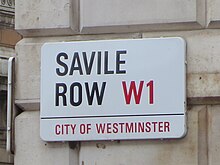
Back Savile Row Afrikaans سافيل رو Arabic Savile Row Danish Savile Row German Σάβιλ Ρόου Greek Savile Row Spanish Savile Row Finnish Savile Row French Savile Row Irish Savile Row Italian
 Savile Row from Burlington Gardens | |
 | |
| Type | Street |
|---|---|
| Owner | Norwegian Oil Fund |
| Maintained by | Westminster City Council |
| Location | London |
| North | Conduit Street |
| South | Vigo Street |
| Construction | |
| Completion | 1735 |
| Other | |
| Designer | Henry Flitcroft |
| Known for | Traditional bespoke tailoring for men |

Savile Row (pronounced /ˌsævɪl ˈroʊ/) is a street in Mayfair, central London. Known principally for its traditional bespoke tailoring for men, the street has had a varied history that has included accommodating the headquarters of the Royal Geographical Society at 1 Savile Row, where significant British explorations to Africa and the South Pole were planned; and more recently, the Apple office of the Beatles at 3 Savile Row, where the band's final live performance was held on the roof of the building.
Originally named Savile Street, it was built between 1731 and 1735 as part of the development of the Burlington Estate. It was designed under the influence of Burlington's interpretation of Palladian architecture, known as "Burlingtonian". Henry Flitcroft, under the supervision of Daniel Garrett, appears to have been the main architect – though 1 and 22–23 Savile Row were designed by William Kent. Initially, the street was occupied mainly by military officers and their wives; later William Pitt the Younger and Irish-born playwright and MP Richard Brinsley Sheridan were residents.
Tailors started doing business in the area in the late 18th century; first in Cork Street, about 1790, then by 1803 in Savile Row itself. In 1846, Henry Poole, later credited as the creator of the dinner jacket, opened an entrance to Savile Row from his tailoring premises in Old Burlington Street. Founded in 1849 by Henry Huntsman, H. Huntsman & Sons moved to No. 11 Savile Row with the ending of the war in 1919.[1] During the First World War, Huntsman's was a tailor to the military, producing dress uniforms for British officers. In 1969, Nutters of Savile Row modernised the style and approach of traditional Savile Row tailoring; a modernisation that continued into the 1990s with the "New Bespoke Movement", involving the designers Richard James, Ozwald Boateng, and Timothy Everest. The term "bespoke" as applied to fine tailoring is understood to have originated in Savile Row, and came to mean a suit cut and made by hand.
Savile Row runs parallel to Regent Street between Conduit Street at the northern end and Vigo Street with Burlington Gardens at the southern. Linking roads include New Burlington Street, Boyle Street, and Clifford Street. The freehold is owned by the Pollen Estate. In 2016 Westminster City Council commenced attempts to protect the street's tailoring heritage under the Savile Row SPA (Special Policy Area).[2] In 2014, Norway's Oil Fund, the world's largest sovereign wealth fund, acquired a 57.8% interest in the Pollen Estate from The Church Commissioners.[3] This includes properties in Mayfair, among which is Savile Row.[3]
- ^ Richard Anderson, Bespoke: Savile Row Ripped and Smoothed, (Simon & Schuster, 2009) p.106
- ^ "Westminster City Plan - Consolidated with all changes since November 2013". Archived from the original on 21 December 2021.
- ^ a b Reed, Stanley (11 August 2014). "Norway's Oil Fund Buys London's Savile Row". The New York Times. Retrieved 18 January 2015.